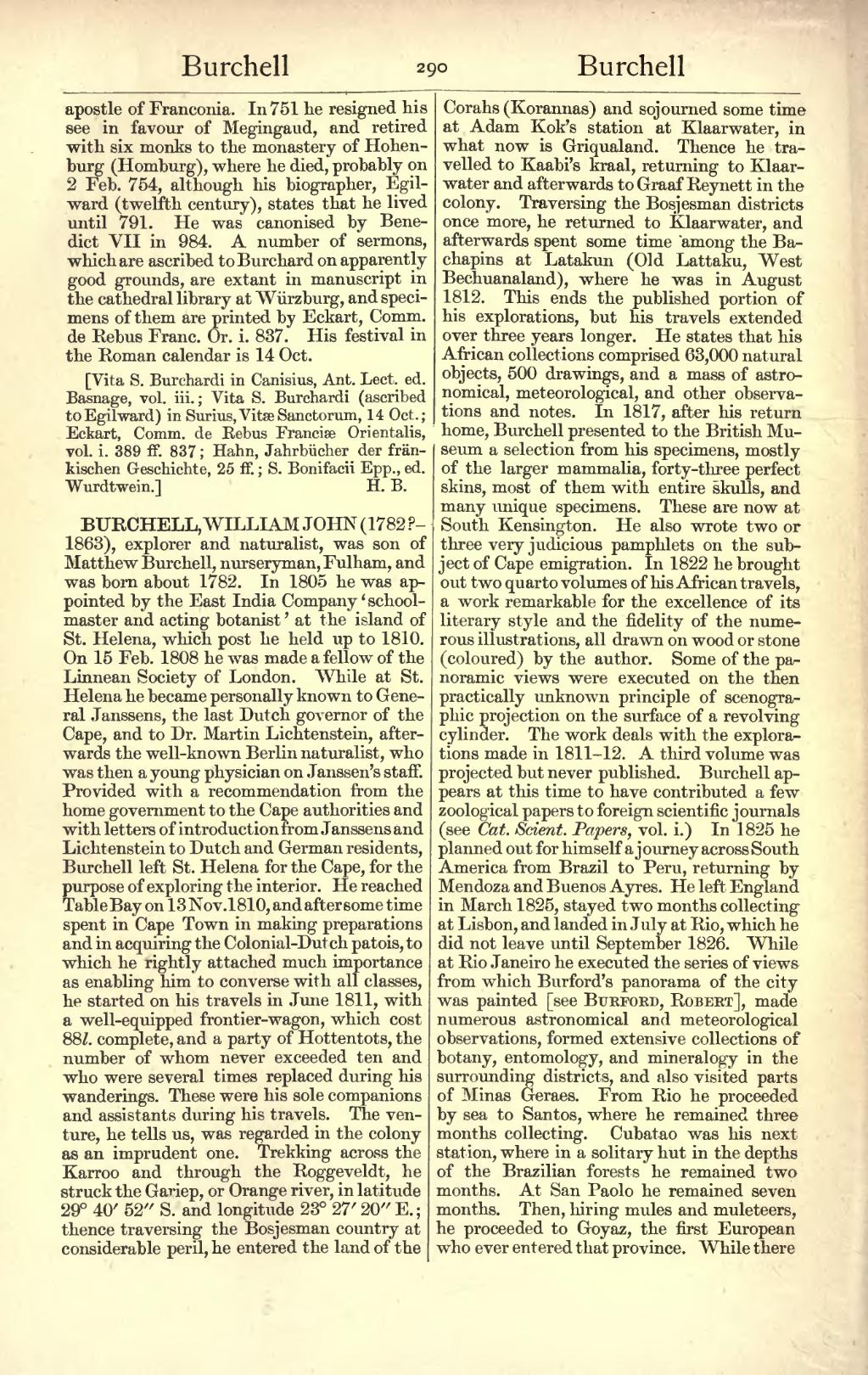apostle of Franconia. In 751 he resigned his see in favour of Megingaud, and retired with six monks to the monastery of Hohenburg (Homburg), where he died, probably on 2 Feb. 754, although his biographer, Egilward (twelfth century), states that he lived until 791. He was canonised by Benedict VII in 984. A number of sermons, which are ascribed to Burchard on apparently good grounds, are extant in manuscript in the cathedral library at Würzburg, and specimens of them are printed by Eckart, Comm. de Rebus Franc. Or. i. 837. His festival in the Roman calendar is 14 Oct.
[Vita S. Burchardi in Canisius, Ant. Lect. ed. Basnage, vol. iii.; Vita S. Burchardi (ascribed to Egilward) in Surius, Vitæ Sanctorum, 14 Oct.; Eckart, Comm. de Rebus Franciæ Orientalis, vol. i. 389 ff. 837; Hahn, Jahrbücher der fränkischen Geschichte, 25 ff.; S. Bonifacii Epp., ed. Wurdtwein.]
BURCHELL, WILLIAM JOHN (1782?–1863), explorer and naturalist, was son of Matthew Burchell, nurseryman, Fulham, and was born about 1782. In 1805 he was appointed by the East India Company ‘schoolmaster and acting botanist’ at the island of St. Helena, which post he held up to 1810. On 15 Feb. 1808 he was made a fellow of the Linnean Society of London. While at St. Helena he became personally known to General Janssens, the last Dutch governor of the Cape, and to Dr. Martin Lichtenstein, afterwards the well-known Berlin naturalist, who was then a young physician on Janssen's staff. Provided with a recommendation from the home government to the Cape authorities and with letters of introduction from Janssens and Lichtenstein to Dutch and German residents, Burchell left St. Helena for the Cape, for the purpose of exploring the interior. He reached Table Bay on 13 Nov. 1810, and after some time spent in Cape Town in making preparations and in acquiring the Colonial-Dutch patois, to which he rightly attached much importance as enabling him to converse with all classes, he started on his travels in June 1811, with a well-equipped frontier-wagon, which cost 88l. complete, and a party of Hottentots, the number of whom never exceeded ten and who were several times replaced during his wanderings. These were his sole companions and assistants during his travels. The venture, he tells us, was regarded in the colony as an imprudent one. Trekking across the Karroo and through the Roggeveldt, he struck the Gariep, or Orange river, in latitude 29° 40′ 52″ S. and longitude 23° 27′ 20″ E.; thence traversing the Bosjesman country at considerable peril, he entered the land of the Corahs (Korannas) and sojourned some time at Adam Kok's station at Klaarwater, in what now is Griqualand. Thence he travelled to Kaabi's kraal, returning to Klaarwater and afterwards to Graaf Reynett in the colony. Traversing the Bosjesman districts once more, he returned to Klaarwater, and afterwards spent some time among the Bachapins at Latakun (Old Lattaku, West Bechuanaland), where he was in August 1812. This ends the published portion of his explorations, but his travels extended over three years longer. He states that his African collections comprised 63,000 natural objects, 500 drawings, and a mass of astronomical, meteorological, and other observations and notes. In 1817, after his return home, Burchell presented to the British Museum a selection from his specimens, mostly of the larger mammalia, forty-three perfect skins, most of them with entire skulls, and many unique specimens. These are now at South Kensington. He also wrote two or three very judicious pamphlets on the subject of Cape emigration. In 1822 he brought out two quarto volumes of his African travels, a work remarkable for the excellence of its literary style and the fidelity of the numerous illustrations, all drawn on wood or stone (coloured) by the author. Some of the panoramic views were executed on the then practically unknown principle of scenographic projection on the surface of a revolving cylinder. The work deals with the explorations made in 1811–12. A third volume was projected but never published. Burchell appears at this time to have contributed a few zoological papers to foreign scientific journals (see Cat. Scient. Papers, vol. i.) In 1825 he planned out for himself a journey across South America from Brazil to Peru, returning by Mendoza and Buenos Ayres. He left England in March 1825, stayed two months collecting at Lisbon, and landed in July at Rio, which he did not leave until September 1826. While at Rio Janeiro he executed the series of views from which Burford's panorama of the city was painted [see Burford, Robert], made numerous astronomical and meteorological observations, formed extensive collections of botany, entomology, and mineralogy in the surrounding districts, and also visited parts of Minas Geraes. From Rio he proceeded by sea to Santos, where he remained three months collecting. Cubatao was his next station, where in a solitary hut in the depths of the Brazilian forests he remained two months. At San Paolo he remained seven months. Then, hiring mules and muleteers, he proceeded to Goyaz, the first European who ever entered that province. While there
